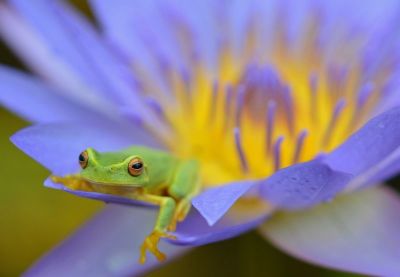The Incredible Way God Equipped Frogs to Ride Out Dry Times

When you think of the natural environs of frog and toads you probably think of ponds, lakes, streams, rivers, marshes, swamps, and other assorted wetlands. Why is that? One major reason is that frogs and toads (along with salamanders) are amphibians and as such, have moist permeable skins so they can actually breathe through it as well as their lungs.
In other words, they aren't waterproof.
Consequently they can lose water through their skin like crazy; frogs faster than toads. Another reason they tend to be around water is that most frogs and toads need to have plenty of it so that they can breed. Many species have aquatic tadpoles so that the main idea is to mate and lay eggs in the water. So if water is such a necessity to these hopping herps why is it that some live where it is bone dry a big chunk of the year – the arid and semi-arid deserts.
It is true that frogs and toads are vulnerable to turning quickly into jerky if in the wrong place at the wrong time. But our Lord equipped many different kinds of frogs that have a fantastic trick to deal with the desert's brutal dry season. The dry season is definitely not the happening time for frogs and toads. The ones that do live there do a lot of nothing underground until the next rainy season.
God has given these frogs the instinct to burrow down while there is still moisture in the soil and get well hydrated. But that's not all. A frog buried underground during the dry season won't prevent jerkification.
Once they start to dry out these frogs are programmed to begin shedding skin repeatedly. Sometimes once a day. Each shed skin detaches from the new skin beneath and adheres to the older outer skin. These thin skins begin to accumulate one inside another in matryoshka-like fashion. Eventually the frog has a multilayered epidermal cocoon that forms a relatively impermeable parchment-like mummy bag. The number of layers can vary but range from a few dozen to over 200 depending on the species. They stop urinating to keep their precious water and they slow down their metabolism so they don't need to breathe as much. Though they can't breathe through their dead-skin mummy bag, it is conveniently perforated at the two nostrils.
Incredible!
Many places on earth can get unbearably hot and dry and yet our Creator and Lord designed many of his moist-loving amphibians to actually ride out the dry times in a mummy bag made of frog skin. When the rains come and soak into this seemingly lifeless bag the frog revives, tears it open and eats the cocoon. It's time to eat and breed. There's no time to lose before the next dry season.
O Lord, how manifold are your works!
In wisdom have you made them all;
the earth is full of your creatures.
Psalm 104:24




























